Imagine walking through a forest in Japan, surrounded by towering cedar trees that have witnessed centuries of history.
As you learn about the art of Echizen lacquerware and the intricate process of lacquering trays, you’ll feel like you’re uncovering a hidden treasure trove of tradition and craftsmanship.
But what exactly goes into creating these exquisite pieces?
Stay tuned to discover the secrets behind this revered art form and how you can be part of it.
Key Points
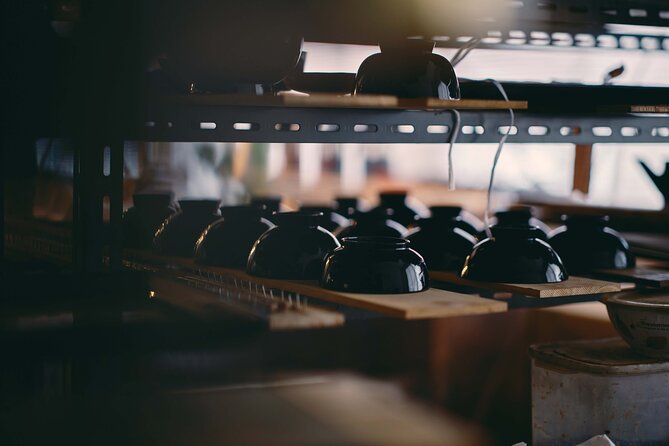
- Echizen Lacquerware reflects centuries-old craftsmanship and cultural heritage.
- Techniques involve precise layering, polishing, and intricate designs.
- Tools like brushes, spatulas, and natural lacquer are essential.
- Process includes priming, decorating, and modern protective finishes for longevity.
Echizen Lacquerware History
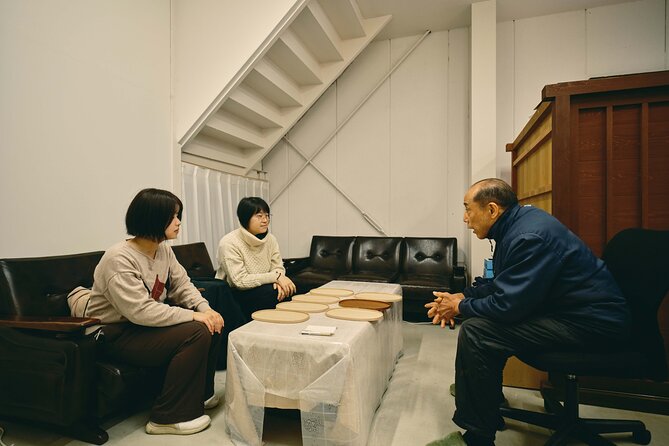
Echizen Lacquerware History dates back centuries, showcasing exquisite craftsmanship and traditional techniques that have been passed down through generations. This Japanese lacquerware originates from the Fukui Prefecture, where artisans meticulously apply layers of urushi lacquer to wood or other materials.
The echizen lacquerware techniques involve a labor-intensive process that requires precision and patience. Artisans mix the lacquer with pigments to achieve various colors, then skillfully coat the base material, allowing each layer to dry before adding the next. The result isn’t only visually stunning but also durable and resistant to water and heat.
This traditional lacquer craftsmanship has stood the test of time, making Echizen Lacquerware a sought-after art form worldwide.
You can also read our reviews of more tours and experiences in Fukui Prefecture.
Techniques of Lacquering Tray Making
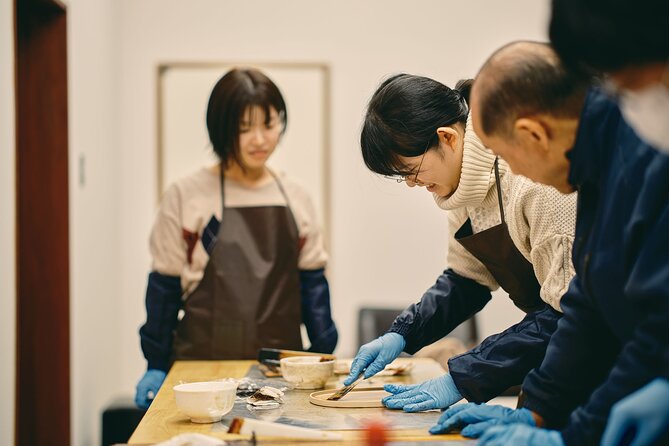
When creating lacquering trays, artisans employ meticulous techniques that involve layering urushi lacquer with precision and care. This ancient craft requires skill and patience to achieve the desired smooth and glossy finish.
Here are some key aspects of lacquering tray making:
- Layering: Artisans apply multiple layers of urushi lacquer, allowing each coat to dry completely before adding the next one.
- Polishing: After the final layer dries, the tray is meticulously polished to enhance its shine and durability.
- Design: Intricate designs or patterns can be added using various techniques like maki-e (sprinkled picture) or chinkin (gold inlay).
- Preservation: Proper care, including avoiding exposure to direct sunlight and harsh chemicals, is essential for lacquerware preservation.
These lacquering trays find modern applications in both traditional and contemporary settings, showcasing the timeless beauty and craftsmanship of Echizen lacquerware.
Tools and Materials Used
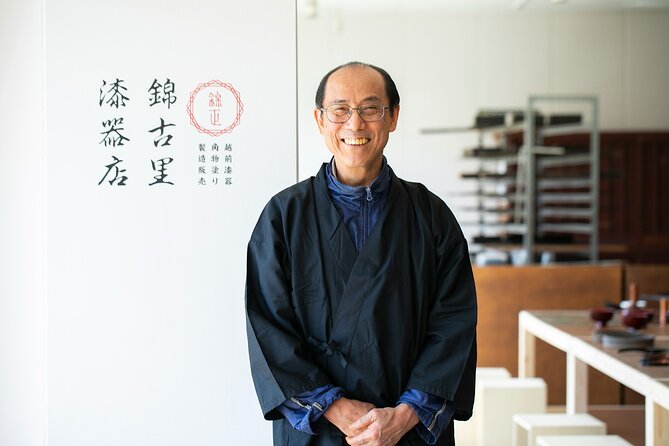
Artisans working on lacquering trays utilize a variety of specialized tools and materials to achieve the intricate and glossy finishes characteristic of Echizen lacquerware.
When it comes to lacquerware tools, artisans rely on items such as brushes made from animal hair or bamboo, spatulas for applying the lacquer, and polishing stones to smoothen the surface.
Along With these tools, artisans use a range of lacquerware materials like natural lacquer sap obtained from the lacquer tree, pigments for coloring, and various types of fillers for decoration and reinforcement.
These tools and materials play a crucial role in the meticulous process of creating Echizen lacquerware, ensuring each piece reflects the traditional craftsmanship and beauty of this art form.
Step-by-Step Process Overview
In crafting Echizen lacquerware, the step-by-step process involves a meticulous series of traditional techniques and precise methods. Here is an overview of how this exquisite art form comes to life:
-
Preparation: The base material is carefully selected and shaped to form the desired item.
-
Priming: Multiple layers of lacquer are applied, with each layer requiring meticulous drying and polishing.
-
Decoration: Traditional techniques like Maki-e are used for intricate designs.
-
Finishing: Modern applications such as protective coatings are applied to enhance durability and longevity.
This blend of traditional techniques with modern applications results in the stunning beauty and quality of Echizen lacquerware.
Importance of Traditional Craftsmanship
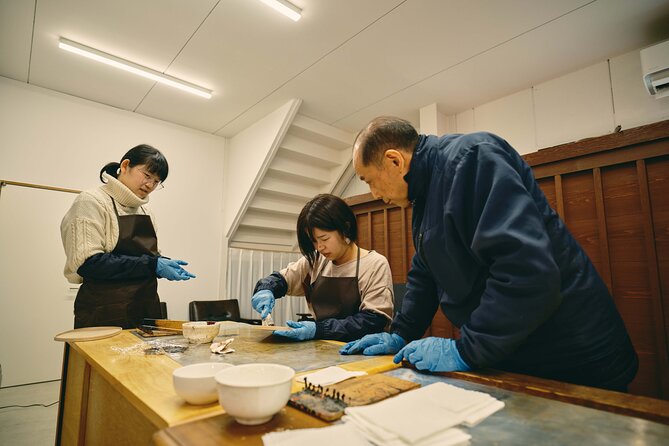
Crafting Echizen lacquerware intricately intertwines traditional techniques with modern applications to elevate the art form’s beauty and quality. The importance of traditional craftsmanship in Echizen lacquerware lies in cultural preservation and the showcasing of artisan skills.
Through craftsmanship appreciation, you can witness the meticulous work that goes into each piece, highlighting the mastery of traditional techniques passed down through generations. By valuing and supporting these traditional methods, the art form continues to thrive, keeping the heritage alive for future generations to appreciate.
The intricate details and expert craftsmanship involved in creating Echizen lacquerware exemplify the dedication to preserving cultural traditions and honoring the legacy of skilled artisans.
- Private Making Your Own Unique Sunglass in Sabae Fukui
- Private Woodworking and Lacquerware Session for Crafting Spoon
- Onigawara and Echizen Tiles Activity
- Personalize Your Own Knife and Visit Knife Handle Making Factory
- Private Countryside Tour From Echizen With Monk
- Experience Tasting Fukuis Local Sake in a Lacquered Glass
Unique Features of Echizen Lacquerware
One notable feature of Echizen Lacquerware is its exquisite use of natural materials to enhance both the beauty and durability of the creations. Echizen lacquerware stands out due to its unique characteristics and the artisan techniques involved in its creation.
Here are some key points that highlight the cultural significance and artistic demonstration of Echizen Lacquerware:
-
Natural Materials: Echizen Lacquerware utilizes organic materials like wood and lacquer to create stunning pieces.
-
Intricate Designs: The lacquerware showcases intricate designs that reflect the artisan’s skill and creativity.
-
Durability: The use of high-quality lacquer makes Echizen Lacquerware durable and long-lasting.
-
Cultural Heritage: Echizen Lacquerware embodies a rich cultural heritage through its traditional craftsmanship and artistic expressions.
Tips for a Memorable Lacquering Tray Experience
For a truly memorable lacquering tray experience, consider engaging with the artisan techniques and cultural heritage of Echizen Lacquerware. To make the most of your experience, here are some tips to ensure you have a fantastic time:
| Tips for a Memorable Lacquering Tray Experience |
|---|
| 1. Embrace Creative Designs |
| 2. Explore Modern Applications |
Common questions
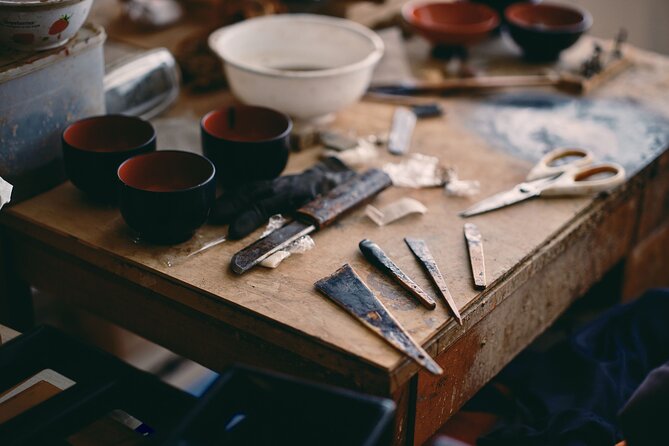
Can Children Participate in the Lacquering Tray Experience?
Children can participate in the lacquering tray experience. Safety precautions are in place to ensure a fun and secure environment. The activity is designed to be engaging for all ages, making it a family-friendly option.
Is There a Minimum Number of Participants Required for the Tour?
There is no minimum number of participants required for the tour. Tour restrictions include moderate physical fitness levels and a lack of accessibility for wheelchairs. It’s a private activity, perfect for smaller groups.
Are There Any Restrictions on What Designs or Patterns Can Be Created on the Lacquering Tray?
When creating lacquering tray designs, participants can draw from various sources for inspiration. Cultural significance often influences patterns. Artistic expression allows for customization, offering a range of design options. Restrictions may apply based on traditional techniques and regional styles.
Can Participants Take Home the Lacquering Tray They Create During the Experience?
Participants can take home the lacquering tray they create during the experience. They have artistic freedom to design custom patterns using traditional lacquer techniques. This hands-on activity allows individuals to showcase their creativity and bring a personalized tray home.
Are There Any Special Precautions or Safety Measures That Participants Should Be Aware of During the Lacquering Tray Experience?
During the lacquering tray experience, participants should be mindful of safety precautions. Adults are welcome, and basic tools are used under supervision. Participants should adhere to lacquer design restrictions for a successful and enjoyable experience.
Sum Up
The ‘Making of Echizen Lacquerware and Lacquering Tray Experience’ offers a fantastic opportunity to take in the world of traditional Japanese craftsmanship.
With a hands-on exploration of lacquerware making, participants can gain insight into the intricate artistry behind this time-honored craft.
Whether you’re a novice or a seasoned artisan, this culture is sure to leave a lasting impression.
Don’t miss out on this unique and unforgettable experience!
More Tour Reviews in Fukui Prefecture
- Experience Tasting Fukuis Local Sake in a Lacquered Glass
- Private Countryside Tour From Echizen With Monk
- Personalize Your Own Knife and Visit Knife Handle Making Factory
- Onigawara and Echizen Tiles Activity
- Private Woodworking and Lacquerware Session for Crafting Spoon
- Private Making Your Own Unique Sunglass in Sabae Fukui
